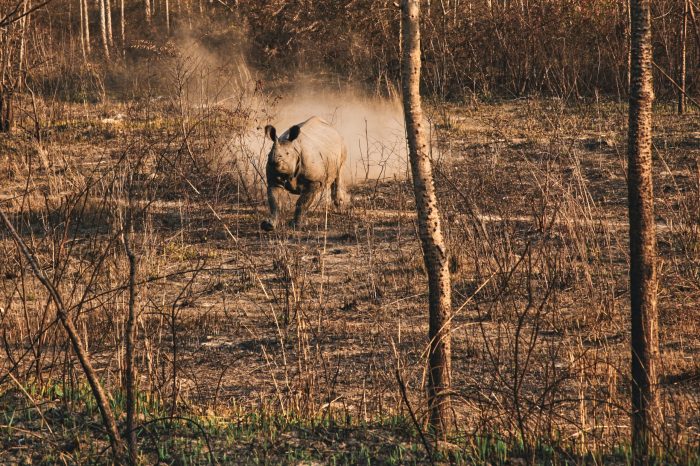
Chitwan National Park was Nepal’s first step towards wildlife conservation and environmental protection. The national park, which spans the districts of Nawalparasi, Parsa, Makwanpur, and Chitwan, is located in the subtropical inner Terai lowlands of south-central Nepal. Chitwan National Park has been attracting environment lovers and wildlife aficionados from its inception 11 years before that, when it was accorded the long-awaited designation of UNESCO World Heritage Site.
Chitwan National Park borders Parsa National Park in the east and India’s Valmiki National Park in the south, forming a 3549-square-kilometer Tiger Conservation Project in the alluvial grasslands. More than 700 kinds of wildlife live in Chitwan’s diverse vegetation, with many more still to be identified. Chitwan is home to a diverse range of animals, including king cobras, rock pythons, monitor lizards, and mugger crocodiles, as well as rare mammals such as the Royal Bengal Tiger, leopards, and rhinos. Although the quantities of some creatures, like as rhinos and gharial crocodiles, have changed over time, the authorities have so far managed to preserve a healthy balance.
Sloth bears, Bengal foxes, badgers, jackals, fishing cats, civets, mongooses, martens, sambars, barking and hog deer, chital, langurs, wild boars, Indian pangolins, flying squirrels, common Indian monkeys, and red muntjac are among the other common creatures. Gaurs from the Churia hills region and wild elephants crossing Indian borders occasionally enter Chitwan.
The abundance of avian life in Chitwan National Park makes it a birdwatcher’s paradise. It is home to a variety of native, uncommon, and migratory bird species. Birds including the Bengal Florican, adjutants, grey-crowned prinia, several species of grass warbles, the almost-threatened Oriental darter, and regulars like egrets, storks, kingfishers, and bitterns breed on the national park’s grasslands. Occasionally, the globally endangered spotted eagle might be seen here. The eastern imperial eagle and goosanders are frequent visits among migrating species. Birds such as parakeets, flycatchers, and sunbirds can also be seen. Vultures, a species we don’t generally think about when we think of birds, are protected here.
It would be unjust to tour Chitwan National Park without paying a visit to the Tharus village, which is home to the park’s indigenous inhabitants. The village may be explored on foot, or you can go old school and take a ride in an oxcart. You should bring a guide with you to explain all the complexities of everyday Tharu life, their history and culture. They have made their home in this village after being displaced. The cultural programme that the indigenous Tharu people perform for the visitors is included in the standard jeep safaris. The Tharu girls and boys, dressed in brilliant and colourful traditional garb, dance to folk music and invite you to join in the fun. The Tharu Cultural Museum is a short distance away and serves the community. It houses the Tharu people’s evolution from ancient times to the present, as told through old and new images, records, weaponry, pottery, and other items they’ve utilised over time. Outside, there are artisan shops where you may buy tiny mementoes to remember your wonderful experience.
While visiting Chitwan National Park, be sure to stop by the Bish Hazari Taal or the 20 Thousand Lake. The term comes from the multiple divisions of the water body present here, which resembles several small and large lakes that are separated but gathered together. This location is usually visited by experienced birdwatchers. Many native and migratory species that you have never seen before use the lake as a nesting and breeding habitat. Chitwan National Park should be on your schedule if you are on a visit to Nepal and are a nature lover.
Most national parks only allow jeep safaris, but this one does not. You can choose from a variety of fascinating and enjoyable activities in Chitwan National Park. While there is a vehicle safari available, which takes you to the Gharial Crocodile Breeding Centre at the Kasara headquarters, that is not all. Chitwan is almost synonymous with elephant back safaris. Riding the world’s largest beasts and touring the forests while inhaling the scent of the wild and anticipating the appearance of a wild animal at any moment is difficult to put into words. However, many people are becoming aware of animal rights and opposing elephant rides because the animals are sometimes mistreated.
The Chitwan National Park is working to ensure that the forest is a safe haven for large species. The Elephant Breeding Centre in this city is one of Asia’s best. When you visit, you’ll notice how well the elephants and their calves are cared for and nourished in a loving, secure environment. You can feed the elephants and bathe them in the Rapti River at another location called Sauraha, which is an entirely different and rewarding experience. Bird-watchers can go for a stroll through the jungle and hire a specialist to guide them through the safest routes with the best chances of seeing birds. A canoe ride is another interesting and pleasant activity.
